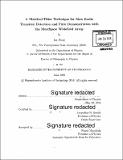A matched filter technique for slow radio transient detection and first demonstration with the Murchison Widefield Array
Author(s)
Feng, Lu, Ph. D. Massachusetts Institute of Technology
DownloadFull printable version (15.00Mb)
Other Contributors
Massachusetts Institute of Technology. Department of Physics.
Advisor
Jacqueline N. Hewitt.
Terms of use
Metadata
Show full item recordAbstract
Many astronomical sources produce transient phenomena at radio frequencies, but the transient sky at low frequencies (< 300 MHz) remain relatively unexplored. Blind surveys with new widefield radio instruments are filling this gap. Although many of these instruments are limited by the classical confusion noise, one can in principle detect transients below the classical confusion limit. This thesis develops a technique for detecting radio transients that is based on temporal matched filters applied directly to time series of images. This technique has well-defined statistical properties and is applicable to variable and transient searches for any instrument. Using the Murchison Widefield Array as an example, we demonstrate that the technique works well on real data despite the presence of classical confusion noise, sidelobe confusion noise, and other systematic errors. We search for transients lasting between 2 minutes and 3 months and improve the upper limits on the transient surface density at 182 MHz for fluxes between ~ 20-200 mJy. We use this technique to characterize detectability of radio afterglows from compact binary coalescence, which are predicted electromagnetic counterparts of gravitational wave (GW) sources and the most promising progenitor of short gamma-ray bursts. While the next generation of GW detectors have come online and detected the first GW event, their ability to localize these events will remain poor during the early days of their operation. Many new widefield radio instruments will be able to cover large areas of the sky in a short amount of time. We use simulated afterglow light curves to estimate the rates of detection for different radio instruments under ideal conditions. We find that some widefield radio instruments might be able to detect radio afterglows and constrain their properties.
Description
Thesis: Ph. D., Massachusetts Institute of Technology, Department of Physics, 2016. Cataloged from PDF version of thesis. Includes bibliographical references (pages 143-154).
Date issued
2016Department
Massachusetts Institute of Technology. Department of PhysicsPublisher
Massachusetts Institute of Technology
Keywords
Physics.